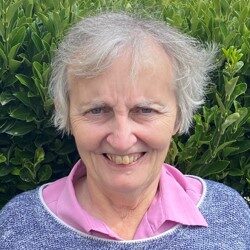
Centering Prayer: A Form of Contemplative Prayer
Having written this story, I had the privilege of hearing Father Laurence Freeman OSB speak. He is the current leader of the World Community for Christian Meditation, following John Main. He graciously agreed to giving an interview, during which he gave a blessing for our time of Chapter. He introduced me to another member of his group, Mrs Pauline Peters. She also gave a beautiful interview where she speaks of meditation and its roots being her Mercy education.
Many of us practice some form of quiet prayer. Groups of us have chosen to meet on a regular basis, during this year of Congregational Chapter, all around the Western Province. We may call it meditation, perhaps following the lead of people like John Main or practices developed by those influenced by the East, such as Anthony De Mello. In this article, I would like to share something of another form that many of you may know and practice already. I share it because it has become a very meaningful practice to me.
Centering Prayer has its origins in the lives of the Desert Mothers and Fathers and has been written about by mystics, the most famous probably being the anonymous author of The Cloud of Unknowing. “In essence, contemplative prayer is simply a wordless, trusting, opening of self to the divine presence.”[1] This description from Cynthia Bourgeault portrays the spending of time, without any props, where we choose to be totally honest in that mysterious space beyond all we can humanly know. She offers the following diagram, attributing it to Thomas Keating. The outermost layer is that of Ordinary Awareness. This contains all our ordinary actions that keep us going from day to day. We need this layer to see about our basic needs but, of course, it is not enough. The middle layer of Spiritual Awareness represents those mystical moments when our very breath is caught intuitively by beauty in some form and we know Otherness to have touched our hearts. Divine Awareness is at the centre of the diagram and is the centre of our being, where we and the Divine are one.

My understanding of Divine Awareness is that it is that which grows within the heart, from faithful, willing, letting go of my agenda, to the risk of living from the loving arms of the Holy One, Who is way beyond anything I can ever understand with my mind. In The Cloud of Unknowing, the anonymous writer speaks of God as being, “a jealous lover … unwilling to work in your will unless you’re willing to be entirely his, and his alone … not asking for your help .. [but] … asking for you …wanting you to lock your eyes on him … completely ready … only waiting on you.”[2]Thus we can recognise from our tradition a God who invites us to gaze, rather than to do anything; asking us to choose to be led rather than having a plan of our own. This author suggests that we use a word of only one syllable, to bring us back to that contemplative space from all the distractions that will come our way. As we practice putting aside all thoughts or distractions, something new is growing within. This is the Unitive Path, of which so many mystics speak.

Cynthia Bourgeault describes the vicious circle from which we can live. A familiar pattern can, for example, turn a frustrating moment towards feelings of anger. She then refers to one of the Desert Fathers, Evagrius, who wrote in the fourth century of “a brief sliver of time before thoughts turned into passions.” And she continues, “if we could be alert to that moment, it would be possible to avoid getting trapped.”[3]The practice of Centring Prayer can enable such inner liberation. Maybe the next time someone contradicts me and I am on the brink sinking into feelings of being misunderstood, or losing myself in anger, that brief sliver may cause me to pause, consider the other person’s point of view and take myself less seriously. This kind of change is echoed by Judy Cannato, where she describes, “within experiences of self-dissolution there are also opportunities for self-transformation.”[4]Her concern is human, active participation in cosmic evolution and she too brings it down to meditation, which she defines as, “about being in the heart and hands of the uncontrollable … free of agenda and attachment.”[5]
Now that we are in Chapter in a new way, and are called to embody such change as talking to each other, rather than about each other, perhaps this deepest of all springs can be a source of rich nourishment. Perhaps, Centred in the God of Mercy, we can renew the face of the Earth!
Juliana of Norwich shares a poem[6]:
For He is the Very Rest
For He is the Very Rest.
God wishes to be known,
And it pleases Him that
We all rest in Him;
For all that is beneath Him
Will never satisfy us.
Therefore no soul is rested
Til it is emptied of all things
That are made.
When, for love of Him,
It is empty,
The soul can
Receive His deep rest.

[1] Bourgeault, C. Centering Prayer and Inner Awakening (Cowley Publications, 2004, UK) p. 5
[2] The Cloud of Unknowing, new translation by Carmen Acevedo Butcher (Shambhala Publications, Inc., Boston. 2009) p. 10
[3] Op Cit, Bourgeault, p. 140
[4] Judy Cannato, Field of Compassion, (Sorin Books, Notre Dame, 2010) p. 36
[5] I bid, p.123
[6] For Lovers of God Everywhere, collection by Roger Housden, (Hay House, USA, 2009) p.188
Suzanne Ryder rsm
Western Province


